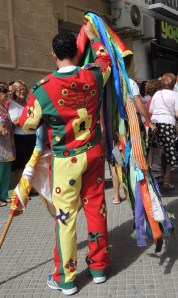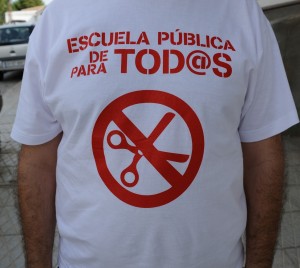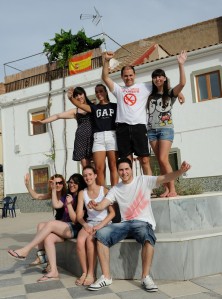The Fiesta de Cascamorras takes place in the towns of Guadix and Baza in the province of Granada, Spain, annually from mid August with the main events on September 6 in Baza and September 9 in Guadix.
The two towns fight for possession of a statue of the Virgen de la Piedad (Our lady of Mercy).
There are differing opinions on the origin and development of this fiesta, however, the most commonly accepted version is outlined below and on the cascamorras website (in english and spanish).
Hope you enjoy the slideshow at the end of this Post.
The year is 1151 and, with the arrival of the Almohads, many of the temples were destroyed. Amongst these was a Mozarabic chapel in a suburb of Baza.
Three hundred years later, Don Luis de Acuña Herrera (one of Ferdinand’s knights) decided to build the Church of our lady of mercy on the site and in 1490 work began.
A workman from Guadix was removing some of the old plasterwork when he heard a soft and sad voice coming from the ground. The voice was crying ‘Have mercy!’ He continued digging and came across a statue of the virgin which was given the name ‘our lady of mercy’.
The workman, Juan Pedernal, competed and argued with the other workmen, each seeking ownership of the statue. Juan argued that our lady had cried out to him and, as he was from Guadix, the statue belonged to Guadix. In the end it was down to the authorities to step in and resolve the ownership argument. Their intervention resolved that the icon was indeed the property of Baza as this was where it was found. They also agreed that there would be an annual religious festival in September every year in both the towns.
It was also agreed that if an appointed representative of Guadix was able to enter the town of Baza and reach the church of mercy ‘without stain’ then he could recover the Virgin for the town of Guadix.
And so, the townspeople of Guadix came every year to Baza to hold a pilgrimage. Their appointed representative was accompanied by a ‘jester’ whose job was to entertain the gentry with jokes and nonsense.
It is believed that this ‘jester’ was the precursor of the present day ‘Cascamorras’ as his look is that of a buffoon or harlequin. His costume of jacket and trousers is red, green and yellow, on the back is a jar of sunflowers and on the front are stars, suns and moons.
The flag he carries is made of six pieces of different coloured cloths: green, white and pink on the front and yellow, red and sky blue on the back. On the white cloth there is an image of our lady of mercy and the whole thing is hoisted from a 2.25 m long wooden mast from which hang ribbons that devout groups, Civil Guard, Fire Brigade and brotherhoods offer to the virgin. There are inscriptions on the ribbons giving thanks from people who are grateful for promises kept, kind acts or favours received.
The truncheon he carries, the only means of defence allowed, is made of a wooden shaft with a piece of string knotted at the end and covered in sheepskin.
Today, before leaving Guadix on his journey to Baza, Cascamorras raises the flag above the heads of the townspeople of Guadix. The people are on their knees around him and he waves the flag above their heads until it is completely furled, and so his journey to Baza begins with cries of ‘viva!’
On arriving at Baza “Cascamorras” smears himself in vaseline, puts his working clothes on and warms up with a few gentle runs, before starting his route through the streets of Baza until reaching the Church of our lady of mercy to try to carry off the image. Hours before, groups of people from Baza congregate at Rodeas up in the hills, painting each other with the blackness of old engine oil giving themselves an impressively spectacular look.
At the sound of the third rocket they run towards Cascamorras in a rush to be the first to paint him. He then starts on his run to the Church, through the streets of Baza. Lots are drawn by the people of Baza to decide who will help him carry the flag along the route. Others make sure the Cascamorras has a rest, they help remove the oil from his eyes, protect him from the crowd, cheer him on and carry him on their shoulders. He has oil smeared on him but he is also bathed in the fountains. He is pushed and jostled but all in the spirit of the fiesta. He defends himself with his truncheon by hitting it on the ground, all of this symbolic and neither he or the crowds are ‘set upon’.
The heat in September is relentless and water is an essential element with the people on balconies throwing buckets of water onto the crowds below.
Along the route the crowds will stop and squat below the Cascamorras and shout for ‘the flag’, so that he can wave it over their heads in honour of ‘our lady of mercy’. The townspeople often ask the Cascamorras to stop at their houses, but one obligatory stop is at the town hall where the revellers will dance in honour of the flag. Arriving at the Church of our lady of mercy the congregation kneel and Cascamorras waves the flag over their heads. They then go into the church and the brotherhood return with candles in memory of the worship given to the virgin on the first day she was taken from her imprisonment. The Cascamorras is washed in the fountain of the church using olive oil and detergent and changes into his multicoloured suit. He passes by the church again to give thanks to the Holy Virgin.
Whilst, this is a spectacular event, it must not be forgotten that it is a tradition with a very deep-rooted religious significance and one which maintains the two towns in perpetual litigation.
The following day “Cascamorras” goes through the streets of Baza accompanied by the drummer. Whenever a group of people ask him he waves the flag over their heads until it is furled and the ritual dancing is repeated and a few days later the whole event is repeated in the town of Guadix.
In 2006, the festival was declared a “Fiesta of National Tourist Interest of Spain” and if ever you are in the area, definately not one to be missed.
More information on the town of Baza can be found at www.bazaturismo.com
Hope you enjoy the slideshow!








